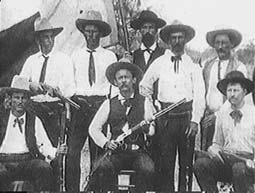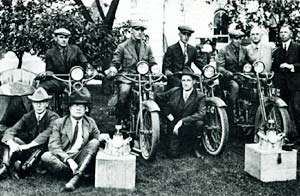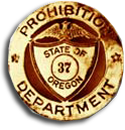 The legendary Texas Rangers were
inspiration to Oregon defense council planners as they developed a new state military police force. (Photo, houstonpbs.org)
The legendary Texas Rangers were
inspiration to Oregon defense council planners as they developed a new state military police force. (Photo, houstonpbs.org)
Organizing the Force
While the Jefferson County Home Guard and other local efforts to protect the home front grew throughout Oregon, officials saw a need for a more organized, statewide presence. By early 1918 they worried about inadequate protection of docks, shipping plants, food warehouses, and other assets from espionage or sabotage by enemy operatives or sympathizers.
The State Council of Defense for Oregon responded by drafting a plan for organizing a state police force. The council modeled the plan after the famed Texas Rangers and other similar forces. At the request of the defense council chairman, the Oregon Legislative Emergency Board met and adopted the plan. The board also provided $250,000 for operating the force through the end of 1918.
The majority of the new guard had seen military duty before, many in the Spanish-American War. The men, mostly between 18 and 45 years old, were issued uniforms from the national guard with campaign hats and leather leggings. They also received Springfield or Winchester rifles. And, the force ordered five automobiles and 12 motorcycles, some with side-cars. Officers were paid according to corresponding military salary while the privates earned $90 per month. Once at strength, the military police numbered about 11 officers and 180 enlisted men.
The Task at Hand
Many of the men were stationed in the Portland area since it had the most potential targets of sabotage or mischief. Officials saw the protection of shipbuilding as vital to the war effort. By November, police had guarded the construction of 61 wooden ships and 20 steel ships in Oregon. Work continued "without the least interruption or interference...," thereby confirming the value of the force to many. As an added value, the defense council reported that the Oregon Military Police discovered and extinguished "three serious fires" on newly built ships, which as a result suffered no substantial damage. Police were also stationed at important mills and other industries deemed essential to the war effort.
A significant portion of the police force, two officers and 50 enlisted men, covered the grain belt of central and eastern Oregon in the summer and fall months. Their goal was to prevent serious damage to crops from fire or "other destruction at the hands of lawless men." Substantial details of the force were stationed in Athena, Condon, Helix, Heppner, La Grande, Maupin, Moro, Pendleton, Pilot Rock, and Umatilla - all communities growing grain needed to feed the American soldiers fighting in Europe. Officials estimated that the police visited and safeguarded nearly 1,500 farms during this duty. Along similar lines, large detachments saw duty fighting 38 forest fires.
Making Arrests
The military police, at the request of local authorities, also nabbed Oregonians who violated the state's prohibition laws related to alcoholic beverages. While Prohibition on a national scale was just around the corner, Oregon began the the experiment in 1916. By November, officers had arrested and secured convictions in 87 liquor law cases. Leaders saw the enforcement of prohibition as part of their role to protect the "public morals" of the state, which, by extension, was important to winning the war. In other actions, the Oregon Military Police also assisted federal authorities in arresting and helping to convict violators in federal courts. The charges included food hoarding, violations of espionage laws, and "other seditious and disloyal acts."
Controversy Follows
 The Oregon Military Police disbanded in 1919. Two years later the State Traffic Division police (shown above) formed and quickly expanded with the explosive growth of automobiles in the 1920s. Many of its members joined the new Oregon State Police in 1931. (OSA, Department of Oregon State Police Sixtieth Anniversary Edition, 1991)
The Oregon Military Police disbanded in 1919. Two years later the State Traffic Division police (shown above) formed and quickly expanded with the explosive growth of automobiles in the 1920s. Many of its members joined the new Oregon State Police in 1931. (OSA, Department of Oregon State Police Sixtieth Anniversary Edition, 1991)
The action by the police force against bootleggers fueled criticism by opponents of Governor James Withycombe and the Oregon Military Police. The Oregon Journal newspaper said that while the police had been formed because of military need, they since had been used for "all sorts of activities." Suspicions even arose in some quarters that military police had "engaged in bootlegging themselves." To make matters worse, a police private's pay of $90 per month was three times the pay of a soldier. Supporters countered that, unlike soldiers, military policemen had to pay for their own "full sustinence."
The end of the war soon brought an end to both the controversy and the Oregon Military Police. Within three weeks all but 15 men were mustered out of service. The governor sought to continue the military police as an ongoing presence. In January 1919 he recommended that the Oregon Legislature establish "a state constabulary of ten or fifteen men as a small mobile force for state police-duty." Withycombe envisioned the organization helping with the enforcement of prohibition and game laws as well as helping to prevent forest fires.
 A state Prohibition agent's badge from the 1920s. (OSA, History of the Oregon State Police, Dept. of State Police, 1981)
A state Prohibition agent's badge from the 1920s. (OSA, History of the Oregon State Police, Dept. of State Police, 1981)
He defended the military police, saying "despite the vicious criticism leveled against this organization by the lawless element, whose habits were rather rudely interrupted by the activities of the state police, and by many well-meaning citizens who were not informed truthfully, the Oregon military police performed an excellent service." But in the end, his opponents won the day.
The organization came to an end March 30, 1919. Law enforcement in Oregon reverted to a fragmented system with separate groups enforcing prohibition, criminal, arson, forestry, fish, game, and other laws. While the State Traffic Division police developed by 1921, it wasn't until 1931 that the Oregon State Police Department was created. In many ways, that force followed in the footsteps of the Oregon Military Police.
Notes
(Oregon State Defense Council Records, Publications and Ephemera, Box 8, Folder 4, Oregon State Council of Defense News Letter, November 1918; Oregon Historical Quarterly, vol. 45, page 124; Governor's Messages to the Legislature, 1919, page 14; History of the Oregon State Police, Department of State Police, 1981)